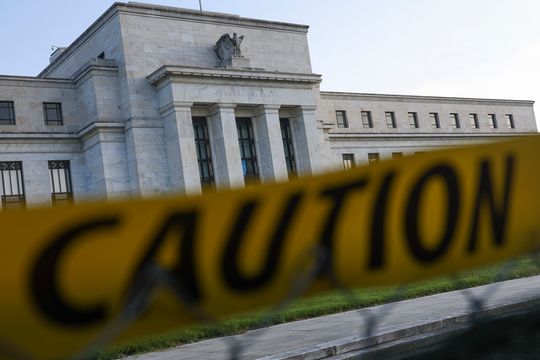What’s next for markets now that the Federal Reserve has delivered its fourth and possibly final jumbo rate increase of 75 basis points?
Well, a lot, actually.
A sometimes tumultuous third-quarter earnings season isn’t over yet. A packed economic-data calendar in the coming weeks includes key readings on inflation and the labor market. On top of that, the U.S. midterm elections could result in Democrats losing control of one, or both, chambers of Congress.
MarketWatch spoke with several market gurus about what investors should watch out for, and what it all might mean for their portfolios.
Inflation, jobs data could force the Fed to keep rates ‘higher for longer’
The Fed may be penciling in another rate increase of 50 basis points at its December meeting, but any sign that inflation isn’t trending toward the central bank’s target still could send stocks reeling and Treasury yields surging, market strategists said.
Indeed, stocks initially rallied after the Fed’s Wednesday policy statement signaled a slower pace of rate increases was in the offing. But indexes ended the day down sharply after Chairman Jerome Powell, in his news conference, said it was premature to “pause” rate hikes and that the terminal — or peak — interest rate was likely to be higher than policy makers had anticipated in September.
Although headline inflation has softened from the fastest pace in more than 40 years, core prices are still accelerating at an uncomfortable rate, and wage growth remains a “mixed bag,” Powell said.
“A lot of what the Fed ultimately does will depend on what happens with inflation,” said Jack Ablin, founding partner and chief investment officer at Cresset Capital.
The consumer-price index for October is due out on Nov. 10, followed by the personal-consumption expenditures index, the Fed’s preferred barometer of inflation pressures, on Dec. 1.
But there’s still plenty to learn about inflation from the October jobs report due out Friday, including its reading on average hourly earnings.
“I think certainly the payrolls number is important, and it all circles back to what it means for inflation,” Ablin said.
Bottom line: Any further indication that the Fed will need to keep interest rates “higher for longer” to combat inflation could exacerbate the weakness in both stocks and bond prices, which move inversely to yields, seen so far this year.
“The increased momentum of inflation sets a high bar for the Fed to end the current rate hike cycle and an even higher one to begin cutting rates,” said Bill Adams, chief economist for Comerica Bank.
Midterms and the return of gridlock
Even if Democrats manage to hang on to both chambers of Congress, investors will likely breath a sigh of relief once Tuesday’s U.S. midterm elections have ended.
“We frequently see stocks rally after the election no matter what the outcome is,” said Callie Cox, U.S. investment analyst at eToro.
Some investors think Republicans retaking the House or the Senate could be bullish for stocks, said Octavio Marenzi, CEO of markets-focused management consulting firm Opimas.
According to Marenzi, a divided Congress would likely lead to more gridlock, which in turn would mean less inherently inflationary fiscal spending.
“Markets might look favorably on a Republican takeover of at least one of the houses [of Congress],” he said.
Earnings remain important
Corporate earnings growth has held up surprisingly well so far this year despite the drumbeat of guidance cuts and ominous rhetoric from corporate executives, said eToro’s Cox.
But the third-quarter earnings season isn’t over yet, which can mean more unpleasant surprises, like what investors saw when Alphabet Inc. GOOG, -3.79%, Meta Platforms Inc. META, -4.89% and Amazon.com Inc. AMZN, -4.82% reported earnings last week.
Investors are still waiting on earnings from more than 150 S&P 500 companies, according to FactSet. Beyond that, there’s also the risk that earnings guidance cuts could weigh on equity prices, market strategists said.
Morgan Stanley Chief U.S. Equity Strategist and Chief Investment Officer Michael Wilson said in recent weeks that guidance cuts may not arrive until companies report fourth-quarter earnings early next year, if at all.
Right now, the S&P 500 is expected to achieve full-year earnings growth of 5.6% in 2022, and 3.9% in 2023, according to Sam Stovall, chief investment strategist at CFRA. That has come down slightly since Sept. 30, when investors anticipated full-year growth of 6.3% and 7%.
A Russian winter offensive could complicate the outlook for markets
The Ukrainian military lately has succeeded in keeping Russian forces at bay. But that could change if Russia launches a winter offensive, according to Marenzi.
Russia already has been calling up thousands of troops and preparing to send them to the front lines.
Historically speaking “winter has been their friend,” Marenzi said about the Russian military. “And I think it might end up being their friend again.”
A Russian advance in Ukraine would likely hurt risky assets like stocks, Marenzi said, while benefiting traditional havens like the dollar, Treasurys and gold GC00, -1.61%.
Speaking of stocks, the major U.S. indexes finished Wednesday sharply lower after a volatile session.
The Dow Jones Industrial Average DJIA, -1.55% tumbled 505 points, or 1.6%, to end at 32,147.76 after briefly topping 33,071 at the session’s high, according to FactSet. The S&P 500 index SPX, -2.50% fell 2.5% and the Nasdaq Composite Index COMP, -3.36% closed 3.4% lower, the biggest daily drop for both indexes since Oct. 7.
Treasury yields TMUBMUSD02Y, 4.703% also climbed after experiencing similar levels of volatility. The yield on the 2-year note rose 3 basis points to 4.568% based on 3 p.m. Eastern Time levels, its highest level in two weeks.

